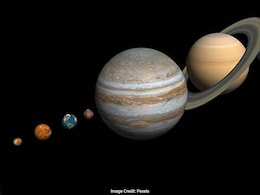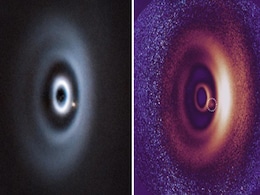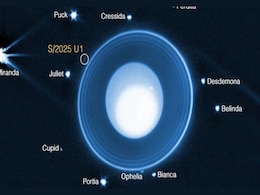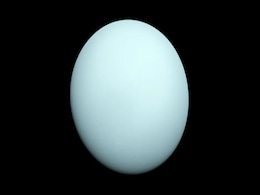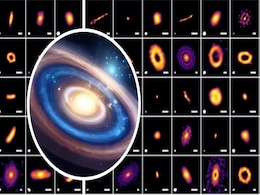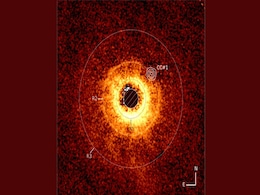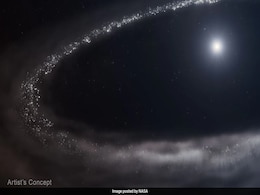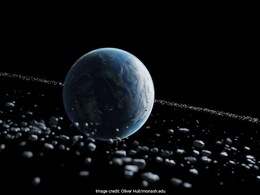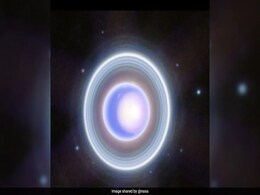Ringed Planet
- All
- News
- Videos
-

A Planet Is Being Born: Astronomers Capture Rare Cosmic Snapshot
- Saturday August 30, 2025
Astronomers have captured a groundbreaking sight: WISPIT 2b, a baby gas giant planet forming within a dusty, multi-ring protoplanetary disk around a young Sun-like star 430 light-years away. Infrared images from the Very Large Telescope show the planet carving a dark path in the rings as it feeds on gas and dust. This rare discovery provides the fi...
-
 www.gadgets360.com
www.gadgets360.com
-

James Webb Telescope Discovers Tiny New Moon Orbiting Uranus
- Saturday August 23, 2025
A team from the Southwest Research Institute has discovered a tiny new moon orbiting Uranus using NASA’s James Webb Space Telescope. The moon, called S/2025 U1, is just 6 miles (10 kilometers) wide, too small for Voyager 2 to detect during its 1986 flyby. This discovery brings Uranus’s total known moons to 29, with S/2025 U1 orbiting 35,000 mil...
-
 www.gadgets360.com
www.gadgets360.com
-

Mysterious Planet Nine May Still Lurk in the Outer Solar System
- Sunday August 3, 2025
Astronomers have long speculated about a hidden planet—Planet Nine—lurking beyond Neptune. First proposed in 2016, the theory explains the strange orbits of distant Kuiper Belt objects through the gravitational pull of a massive, unseen world. Caltech researchers remain confident, while others suggest alternatives like debris rings or even a bl...
-
 www.gadgets360.com
www.gadgets360.com
-

Uranus Found Emitting Internal Heat, Reviving Hopes for Flagship NASA Mission
- Thursday July 17, 2025
Astronomers have discovered that Uranus emits 12% more heat than it receives from sunlight, contradicting past data from Voyager 2. The internal warmth likely comes from leftover energy in the planet’s core, offering clues to its tilt and interior structure. This unexpected heat has intensified calls for a flagship NASA mission to Uranus. Scienti...
-
 www.gadgets360.com
www.gadgets360.com
-

Did Something Hit Saturn? Astronomers Investigate Possible Impact Flash
- Wednesday July 9, 2025
- Science |
Unlike rocky planets where asteroid impacts leave visible craters, gas giants like Saturn have outer layers of hydrogen and helium that can absorb impacts without obvious traces.
-
 www.ndtv.com
www.ndtv.com
-

Astronomers Discover Baby Planets Taking Their First Steps in Nearby Stellar Nursery
- Monday June 30, 2025
Astronomers have detected early signs of planet formation in 27 young protoplanetary disks within the Ophiuchus star-forming region, just 460 light-years away. High-resolution imaging revealed spiral and ring patterns forming earlier than expected, suggesting stars and planets may grow together from infancy. The findings bridge a knowledge gap betw...
-
 www.gadgets360.com
www.gadgets360.com
-

James Webb Telescope Captures First Direct Image of Saturn-Mass Exoplanet
- Friday June 27, 2025
NASA’s James Webb Space Telescope has reached a major milestone by capturing its first direct image of TWA 7 b, a newly discovered Saturn-mass exoplanet orbiting the young star TWA 7. Using a coronagraph to block starlight, Webb identified the planet embedded in the star’s dusty ring system. TWA 7 b is the smallest exoplanet ever imaged dir...
-
 www.gadgets360.com
www.gadgets360.com
-

Mars’ Moons Phobos and Deimos Could Be Asteroid Debris, New Study Reveals
- Thursday November 21, 2024
New research proposes that Mars’ moons, Phobos and Deimos, could have originated from an asteroid torn apart by the planet’s gravity. Simulations show that this shredded asteroid could have formed a ring around Mars, eventually coalescing into the moons. The theory is being tested through the upcoming Mars Moons Exploration mission, which could...
-
 www.gadgets360.com
www.gadgets360.com
-

Earth Had Ring System Similar To Saturn Roughly 466 Million Years Ago: Study
- Tuesday November 19, 2024
- World News |
Like Saturn, Earth may have also had its ring system circling the planet 466 million years ago, according to a study.
-
 www.ndtv.com
www.ndtv.com
-

November Night Sky 2024: Check Out the Brightest Planets and How to Watch Them?
- Monday November 4, 2024
November's night sky features a spectacular lineup of planets, including Venus, which becomes increasingly prominent in the west. Mars glows brightly as it approaches Earth, while Jupiter rises in the east, captivating observers with its brilliance. Saturn, with its magnificent rings, is also visible high in the southern sky. This month presents id...
-
 www.gadgets360.com
www.gadgets360.com
-

NASA Shares Images Of Uranus' Glowing Rings, "Faint And Diffuse" Feature
- Tuesday December 19, 2023
- Science |
The very faint and diffuse Zeta ring, which is closest to the planet and appears reddish brown in the new images, is visible for the first time.
-
 www.ndtv.com
www.ndtv.com
-

A Planet Is Being Born: Astronomers Capture Rare Cosmic Snapshot
- Saturday August 30, 2025
Astronomers have captured a groundbreaking sight: WISPIT 2b, a baby gas giant planet forming within a dusty, multi-ring protoplanetary disk around a young Sun-like star 430 light-years away. Infrared images from the Very Large Telescope show the planet carving a dark path in the rings as it feeds on gas and dust. This rare discovery provides the fi...
-
 www.gadgets360.com
www.gadgets360.com
-

James Webb Telescope Discovers Tiny New Moon Orbiting Uranus
- Saturday August 23, 2025
A team from the Southwest Research Institute has discovered a tiny new moon orbiting Uranus using NASA’s James Webb Space Telescope. The moon, called S/2025 U1, is just 6 miles (10 kilometers) wide, too small for Voyager 2 to detect during its 1986 flyby. This discovery brings Uranus’s total known moons to 29, with S/2025 U1 orbiting 35,000 mil...
-
 www.gadgets360.com
www.gadgets360.com
-

Mysterious Planet Nine May Still Lurk in the Outer Solar System
- Sunday August 3, 2025
Astronomers have long speculated about a hidden planet—Planet Nine—lurking beyond Neptune. First proposed in 2016, the theory explains the strange orbits of distant Kuiper Belt objects through the gravitational pull of a massive, unseen world. Caltech researchers remain confident, while others suggest alternatives like debris rings or even a bl...
-
 www.gadgets360.com
www.gadgets360.com
-

Uranus Found Emitting Internal Heat, Reviving Hopes for Flagship NASA Mission
- Thursday July 17, 2025
Astronomers have discovered that Uranus emits 12% more heat than it receives from sunlight, contradicting past data from Voyager 2. The internal warmth likely comes from leftover energy in the planet’s core, offering clues to its tilt and interior structure. This unexpected heat has intensified calls for a flagship NASA mission to Uranus. Scienti...
-
 www.gadgets360.com
www.gadgets360.com
-

Did Something Hit Saturn? Astronomers Investigate Possible Impact Flash
- Wednesday July 9, 2025
- Science |
Unlike rocky planets where asteroid impacts leave visible craters, gas giants like Saturn have outer layers of hydrogen and helium that can absorb impacts without obvious traces.
-
 www.ndtv.com
www.ndtv.com
-

Astronomers Discover Baby Planets Taking Their First Steps in Nearby Stellar Nursery
- Monday June 30, 2025
Astronomers have detected early signs of planet formation in 27 young protoplanetary disks within the Ophiuchus star-forming region, just 460 light-years away. High-resolution imaging revealed spiral and ring patterns forming earlier than expected, suggesting stars and planets may grow together from infancy. The findings bridge a knowledge gap betw...
-
 www.gadgets360.com
www.gadgets360.com
-

James Webb Telescope Captures First Direct Image of Saturn-Mass Exoplanet
- Friday June 27, 2025
NASA’s James Webb Space Telescope has reached a major milestone by capturing its first direct image of TWA 7 b, a newly discovered Saturn-mass exoplanet orbiting the young star TWA 7. Using a coronagraph to block starlight, Webb identified the planet embedded in the star’s dusty ring system. TWA 7 b is the smallest exoplanet ever imaged dir...
-
 www.gadgets360.com
www.gadgets360.com
-

Mars’ Moons Phobos and Deimos Could Be Asteroid Debris, New Study Reveals
- Thursday November 21, 2024
New research proposes that Mars’ moons, Phobos and Deimos, could have originated from an asteroid torn apart by the planet’s gravity. Simulations show that this shredded asteroid could have formed a ring around Mars, eventually coalescing into the moons. The theory is being tested through the upcoming Mars Moons Exploration mission, which could...
-
 www.gadgets360.com
www.gadgets360.com
-

Earth Had Ring System Similar To Saturn Roughly 466 Million Years Ago: Study
- Tuesday November 19, 2024
- World News |
Like Saturn, Earth may have also had its ring system circling the planet 466 million years ago, according to a study.
-
 www.ndtv.com
www.ndtv.com
-

November Night Sky 2024: Check Out the Brightest Planets and How to Watch Them?
- Monday November 4, 2024
November's night sky features a spectacular lineup of planets, including Venus, which becomes increasingly prominent in the west. Mars glows brightly as it approaches Earth, while Jupiter rises in the east, captivating observers with its brilliance. Saturn, with its magnificent rings, is also visible high in the southern sky. This month presents id...
-
 www.gadgets360.com
www.gadgets360.com
-

NASA Shares Images Of Uranus' Glowing Rings, "Faint And Diffuse" Feature
- Tuesday December 19, 2023
- Science |
The very faint and diffuse Zeta ring, which is closest to the planet and appears reddish brown in the new images, is visible for the first time.
-
 www.ndtv.com
www.ndtv.com

